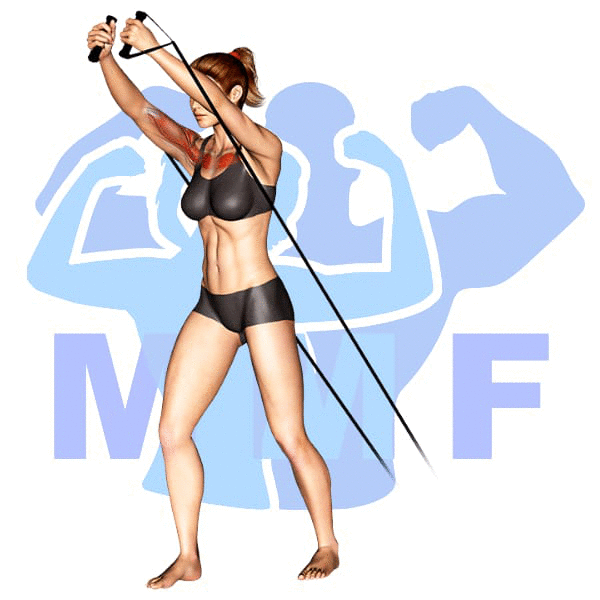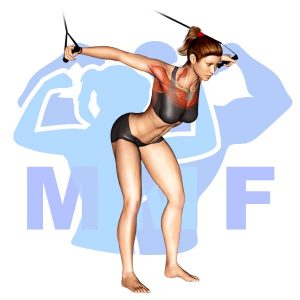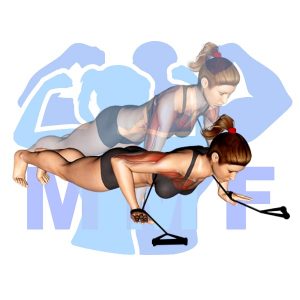Are you tired of struggling to get that chiseled chest you’ve always wanted? Do traditional chest exercises leave you feeling like you’re not seeing results? Perhaps it’s time to try resistance band low chest flys. It’s not uncommon for people to hit a plateau in their chest workout routine, or to struggle with getting a full range of motion with traditional chest exercises. But don’t worry, incorporating resistance band low chest flys into your routine can not only provide a new challenge, but also target your chest muscles in a way that traditional exercises can’t. In this blog post, we’ll dive into the benefits and proper form of resistance band low chest flys to help you achieve that chest you’ve been working towards.
Resistance Band Low Chest Flys Summary
- Primary Muscles: Pectoralis Major – Sternal
- Secondary Muscles: Latissimus Dorsi, Pectoralis Major – Clavicular, Pectoralis Minor, and Rhomboids
- Equipment: Resistance Band and Door Anchor
- Mechanics Type: Isolation
- Force: Push
- Utility: Auxiliary

Resistance Band Low Chest Flys Instructions
- Attach the resistance bands to your anchor point near the floor.
- While facing away from the anchor point grab the handles with both hands.
- Then step out with your arms extended out to your side at about a 45-degree angle to the floor. You must also ensure that your torso is erect and the band is tight.
- Next, bring the handles together in a hugging motion out in front of and above your face.
- You should only hinge at your shoulders and you should be utilizing your upper chest to pull the handles together.
- Finally, complete the rep by allowing your arms to return to your side while stretching out your upper chest
- Repeat your high flys for 8-12 reps.
Video Tutorial
Resistance Band Low Chest Flys Muscles
Target (Agonist)
- Pectoralis Major, Sternal
Synergists
- Latissimus Dorsi
- Pectoralis Major – Clavicular
- Pectoralis Minor
- Rhomboids
Dynamic Stabilizers
- None
Stabilizers
- Biceps Brachii
- Brachialis
- Obliques
- Rectus Abdominis
- Triceps Brachii
- Wrist Flexors
Antagonist Stabilizers

Benefits of Resistance Band Low Chest Flys
The Resistance Band Low Chest Fly is an excellent exercise for strengthening the Pectoralis Major – Sternal muscle. This exercise helps to build strength, enhance stability and control, and improve overall upper body posture. The low chest fly strengthens the chest, shoulders, and arms while also helping to improve shoulder mobility. The exercise works the sternal portion of the pectoralis major muscle which is responsible for the shoulder joint’s rotational movement. This exercise can be done with both light and heavy bands for varying levels of intensity, making it suitable for all fitness levels. Performing this exercise regularly will help to tone and shape the chest, shoulders, and arms while providing increased stability, mobility, and posture.
Tips for Performing Resistance Band Low Chest Flys
If you would like to get the greatest gains, stick to these straightforward tips. Similarly, if you would like to minimize the chance of injuries, follow these tips.
Benefits and Tips Video
Frequent Mistakes To Avoid
You ought to stop these regular mistakes to support solid form and strength gains. Furthermore
- Don’t have unequal tension on each side, or you will utilize both sides with an imbalance.
- Don’t Allow Yourself To Cheat. In nearly all cases, cheating is employing momentum rather than the strength of your main muscle. From time to time, a little bit cheating on your final rep can be good to overload your muscle, but not for more than a handful of reps.
Find More Resistance Band Exercises Here
Variations and Complementary Exercises
Other exercises that can be done in place of or in addition to Resistance Band Low Chest Flys include variations, complementary, and alternative exercises. These exercises can be used to increase the difficulty of the exercise, target different muscle groups, or just mix up your workout routine. Here are some variations, complementary, and alternative exercises that can be used to supplement the Resistance Band Low Chest Flys.
Resistance Band High Chest Flys

Resistance Band High Chest Flys is a complementary exercise to Resistance Band Low Chest Flys. It works the same muscles as the low chest flys but at a different angle. The high chest flys target the upper chest muscles, while the low chest flys target the lower chest muscles. This exercise provides a great way to ensure that all of the chest muscles are worked out, rather than just focusing on one area. This exercise also works the arms and shoulders, providing an additional level of difficulty and an opportunity to add more intensity to the workout.
Resistance Band Flys

Resistance Band Flys are a great complementary or alternative exercise for Resistance Band Low Chest Flys. Resistance Band Flys are similar to the Low Chest Flys, but instead of using a low chest press motion, you move the band out and away from your body in an arc-like motion. This exercise targets the same muscles as the Low Chest Flys, but with a different range of motion. Resistance Band Flys will help to increase shoulder and chest strength, as well as improve shoulder stability. The benefit of using Resistance Band Flys is that you can adjust the resistance level to your own fitness level, making this exercise suitable for both beginners and advanced exercisers.
Resistance Band Chest Press

Resistance Band Chest Press is a great complementary or alternative exercise for Resistance Band Low Chest Flys. This exercise can help target the chest, shoulders and triceps muscles in a similar way as the low chest flys. To perform the resistance band chest press, you will need a resistance band and a sturdy surface. Start by looping the band around your back and grip it with both hands in front of you. Push the band away from your chest as you extend your arms out, then slowly return to the start position. This exercise will help strengthen the chest and shoulder muscles while providing an intense workout.
Check Out These Top Resistance Band Exercises
Resistance Band Push Ups

Resistance Band Push Ups are a great complement to Resistance Band Low Chest Flys. The push up is an exercise that increases strength in the chest, triceps, and shoulders. The band creates additional tension to the movement, forcing more muscle fibers to be activated. It also helps to increase stability and balance throughout the exercise. By alternating between Resistance Band Low Chest Flys and Resistance Band Push Ups, you can target the same muscle groups but with different levels of intensity. This allows you to have an effective and efficient workout.
Feet Elevated Push Up

Feet Elevated Push Ups are a great complement or alternative exercise to Resistance Band Low Chest Flys. This exercise strengthens the chest, shoulders, triceps, and core while also helping to improve balance and stability. To perform Feet Elevated Push Ups, begin in a push up position with your feet on a raised surface. Lower your body until your chest is close to the floor and then push back up to the starting position. The higher the surface your feet are on, the more challenging the exercise will be. By adding Feet Elevated Push Ups to your routine, you can target the same muscles as Resistance Band Low Chest Flys while also improving overall balance and stability.
Close Grip Push Up On Knees

Close Grip Push Up On Knees is a great complementary or alternative exercise to Resistance Band Low Chest Flys. This exercise strengthens the chest, triceps, and shoulder muscles while also providing stability and balance. It is done by getting into a push-up position on the knees and placing your hands close together. Keep your elbows close to your body as you lower your chest towards the ground and press back up. This exercise works the chest in a different way than Resistance Band Low Chest Flys, but it still provides similar benefits.
Find More Chest Exercises Here
Opposing Complementary Exercises
To fully benefit from the exercise Resistance Band Low Chest Flys, it is important to also work the opposing muscle groups. This will give your body balance and help you to see even better results. The following exercises are great for working the opposing muscle groups:
Bent Over Rotating Dumbbell Row

The Bent Over Rotating Dumbbell Row is a great complement to the Resistance Band Low Chest Flys. This exercise works the opposing muscle group of the chest, targeting the upper back, lats, and rear deltoids. It is an excellent way to increase strength and stability in the back and shoulders, as well as develop a balanced body. By doing this exercise after Resistance Band Low Chest Flys, it helps to ensure that all muscles are evenly developed, leading to a stronger, healthier body.
Bent Over Dumbbell Row

The Bent Over Dumbbell Row is a great exercise to complement Resistance Band Low Chest Flys as it works the opposing muscle group. This exercise targets the back, specifically the rhomboids and lats, while the Resistance Band Low Chest Flys focus on the chest and shoulders. By targeting opposing muscle groups, this exercise combination helps to develop balance, strength, and stability in the upper body. Additionally, Bent Over Dumbbell Rows increase your range of motion and can help to improve posture.
Seated Underhand Cable Row

The Seated Underhand Cable Row is an excellent exercise to complement Resistance Band Low Chest Flys. This exercise targets the back muscles, specifically the rhomboids, lats, and traps, while the Resistance Band Low Chest Flys target the chest muscles. By working opposing muscle groups, you can create balance and stability in your body and ensure that your muscles are working together correctly. Additionally, the Seated Underhand Cable Row can help strengthen your upper back muscles, which will help support your posture and make it easier to perform other exercises.
Fly High with Resistance Band Low Chest Flys!
Resistance band low chest flys are an excellent way to target your chest muscles while avoiding the need for any bulky equipment. By incorporating these exercises into your routine, you’ll be able to increase the strength and size of your chest, giving your upper body a more defined look overall. Resistance band low chest flys are also a great choice for those just starting out on their fitness journey or those with limited space at home since they can easily be performed in a small area. So grab your resistance bands and get ready to fly high with these simple yet effective exercises!
References: Wikipedia | ExRx.net | PubMed.gov | Comprehensive List of Chest Resistance Band Exercises

